How To Install Baseboard To Concrete Wall

Baseboard and shoe molding dress up a new hardwood flooring installation. After you've put in the time installing the new flooring, trimming it out frames the floor, showcasing the hardwoods simply similar a quality frame showcases quality art.
Baseboard comes in many different shapes and sizes and should be picked based on a balanced approach to style and money. The simplest builder-grade primed white baseboard can exist purchased at Home Depot or Lowes for around $0.30 / linear pes, while stain-grade elaborate baseboards tin can cost every bit much every bit $iv.00/linear foot.
While most baseboards consist of a single board, elaborate baseboards can take 2 split up components installed on top of one another to give a deeper look, with shoe molding tacked on top of that. Of grade, almost modern homes will have the traditional–and ubiquitous–single lath 3.v″ molding that we cover in this article.
This article is role of our serial on hardwood floor installation. To follow along, subscribe using the RSS and e-mail buttons on the correct. For a complete list of the manufactures in the series, encounter this chief article on installing hardwood floors.
Measuring For Baseboard and Shoe Molding and Selecting Size
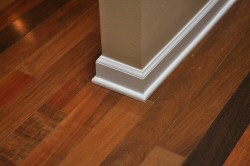 In nigh installations, baseboard will cover every linear foot of wall space with the exception of door jambs. Measure the wall space and add 20% to your calculation for waste–less if you lot are purchasing precise lengths.
In nigh installations, baseboard will cover every linear foot of wall space with the exception of door jambs. Measure the wall space and add 20% to your calculation for waste–less if you lot are purchasing precise lengths.
Baseboards are bachelor in 12 foot and 16 foot lengths, and the big box stores volition allow you to cut pieces of baseboard to exact lengths. You'll detect that contractor packs of baseboard available at the big boxes (usually containing 120 linear feet — 10 12-foot boards) are significantly cheaper than ownership piecemeal–equally much as 50% less. The disadvantage of these packs is that (1) you must buy in majority; and (2) you are limited to 12 foot lengths.
When considering whether sixteen foot lengths are worthwhile, y'all should appraise whether any of the walls in your business firm are betwixt 12 and 16 feet long. The reason being, if the walls are 12 anxiety or less, 12 foot lengths will exercise just fine. If they are larger than xvi feet, but smaller than 24 feet, you'll have to use ii pieces regardless of whether you purchased 12 human foot or 16 foot lengths. (A similar rules applies between 24 and 32 feet, where sixteen-foot lengths can reduce the number of joints — just at 33 feet you'd need 2 joints regardless of 12 or 16 foot pick). In any case, even for 14 foot walls, a good articulation will be invisible to the casual observer, and then 12 human foot boards can exist used throughout.
Simple Joints – Along a Long Wall
When a wall is also long to use a unmarried piece of baseboard, two boards must be joined cease-to-end. The right way to do this is to cutting opposing 45 degree angled mitre cuts. To ensure the baseboard stays tight against the wall, find a stud and terminate the tiptop mitre cut merely beyond it, sinking a finish nail near the end of the board. This ensures the baseboard stays tight against the wall. In the drawing below, the left piece of baseboard will hold the right piece snugly against the wall.

It is helpful to find a spot on the wall that isn't particularly bowed to do the join. Here's a apace washed joint in our installation. For maximum results, it could be sanded and painted to make the joint virtually invisible.
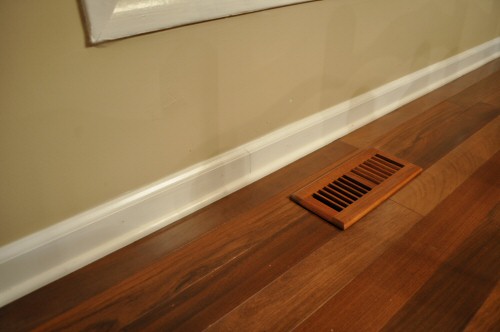
Inside Corners: Coping with Pain or Mitre and Run
Inside corners are the most common in a habitation. Almost regular rooms have 4 inside corners. At that place are two ways to cut molding for inside corners: coping and 45/45 mitres. Let'south start with the easier of the 2: 45/45 mitres.
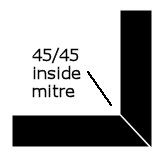 Method Ane: 45/45 mitre cuts join baseboard by cutting opposing 45 caste angles into the baseboard. These joints can await perfect if the wall makes an verbal 90 caste angle or is really, really close to it and you have a very good mitre saw.
Method Ane: 45/45 mitre cuts join baseboard by cutting opposing 45 caste angles into the baseboard. These joints can await perfect if the wall makes an verbal 90 caste angle or is really, really close to it and you have a very good mitre saw.
If the wall isn't 90 degrees, a 45/45 cut will go out a large gap, or it simply won't fit. It is possible to use a sliding protractor to mensurate the exact bending of a wall and suit the mitre angle to recoup, but this tin can exist wearisome.
With this method, paintable caulk (elastomeric sealer) is used to close any apparent gaps. Annotation that since caulk is a primary ingredient in this method, information technology isn't the best arroyo for stained baseboard. For stained baseboard, cope cut provides ameliorate results. Read hither for more thoughts virtually painting vs. staining molding.
Hither'southward a picture of a 45/45 cutting going into place on an inside corner.
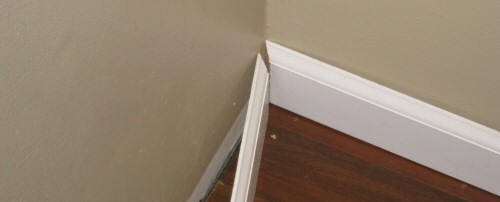
If y'all use the 45/45 method, it can exist helpful to cut the wood just slightly long and bend it into place (this is easier if you're using contractor grade materials built from MDF.
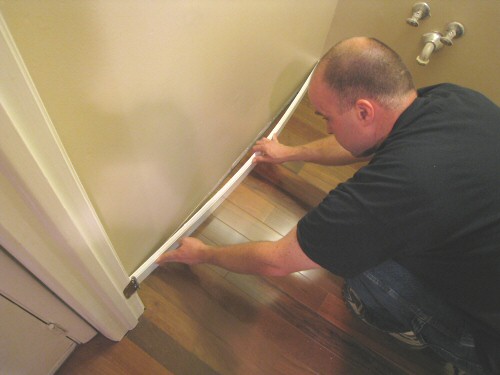
And finally, here'due south the finished production (with shoe molding):
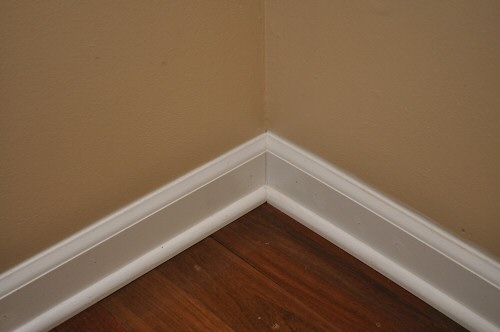
Method Two: The harder method for joining inside corners is cope cutting. Coping consists of laying ane baseboard flush against the wall and cutting the other baseboard to match the curvatures of the first. True carpenters volition argue that coping produces ameliorate, longer lasting joints. We've already written extensively on cope cut baseboard in the article linked higher up. If you lot're interested in this method, start there for instructions.
Exterior Corners: 45 Caste Joins
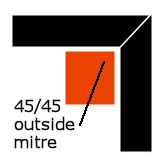
Outside corners work similarly to inside corners and are joined at 45/45 degree angles. They are functionally similar to inside 45/45 mitres except that they piece of work in opposite. Again, when a wall is xc degrees square, these work great.
When the wall is out of foursquare, some adjustment may demand to be fabricated to go the boards to wait current. If yous're planning to stain baseboard, extreme care should be taken with the outside mitres every bit at that place is no room for error.
Here's a picture of an exterior corner in our installation.
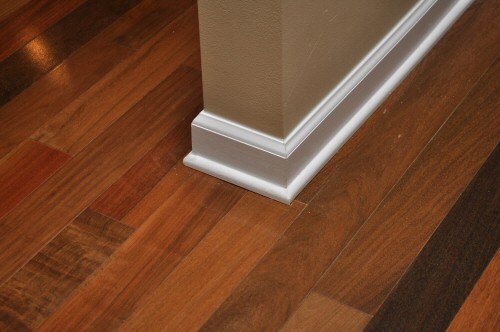
Fastening Baseboard to the Wall
Most baseboard can be fastened to the wall on the studs using a 16 gauge stop nailer with 1.five inch nails. We used the DuoFast Floormaster 250BN for this job. A stud finder comes in handy for locating the studs.
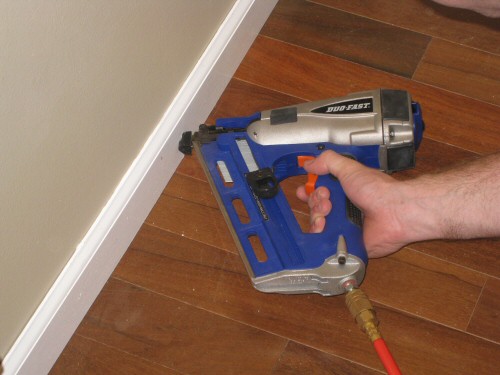
Tip: Baseboard should not be attached to the floor, which inhibits floor expansion below the baseboard.
Installing Shoe Molding
Shoe molding follows all of the same principles as baseboard in terms of cuts and placements. The only deviation is that the measurements are shorter because shoe sits inside the perimeter of the baseboard.
Note that while baseboard is dimensionally stable vertically, shoe molding is designed to be very flexible in 2 dimensions, allowing it to "hug the floor", endmost whatever visible gaps due to dips in the subfloor that are transmitted to the surface. This is one major reward of using shoe molding along with baseboard — it hides both vertical and horizontal gaps.
You lot should fasten shoe molding using an eighteen gauge finish nailer with 1 inch nails. 16 judge nails are likely to split shoe molding and will exist more easily visible on the minor surface.
Tip: Shoe molding should be tacked to the baseboard, not the floor, which inhibits floor expansion beneath the shoe molding.
Tool to Cut Baseboard and Shoe Molding
For most baseboards, a simple 10″ mitre saw that tin can make 45 degree cuts is sufficient. For baseboards taller than four.5″, y'all'll likely need to lay the baseboard flat and use a compound mitre saw (and preferably a dual-compound mitre that tin can rotate 45 degrees toward either side).
We used our Kobalt Sliding Chemical compound Mitre saw for the entire job, simply we didn't brand utilise of either the compound or sliding features.
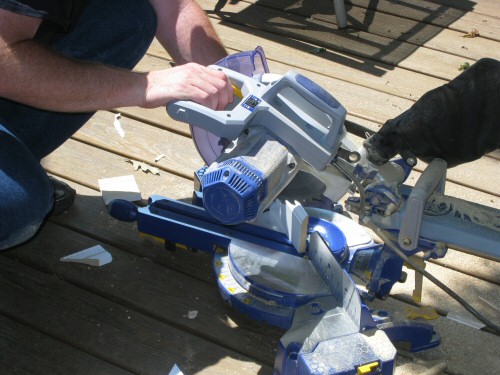
What practice you lot think? Do yous have whatever baseboard or shoe molding tips to add together?
P.S. Stay tuned tomorrow for the final "after" shots of the entire installation!
Source: https://www.oneprojectcloser.com/how-to-install-baseboard-and-shoe-molding-for-hardwood-floors/
Posted by: kingbetimesely.blogspot.com


0 Response to "How To Install Baseboard To Concrete Wall"
Post a Comment